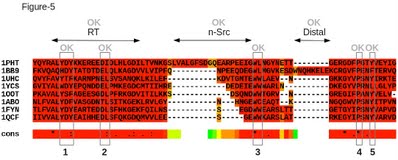Expresso is the most accurate mode of T-Coffee. In Expresso, the templates are fetched automatically by BLAST. By default, PDB structures whose similarity to the original sequence is higher than 30% can be used as a template (this cutoff can be changed -see the troubleshooting section-). Expresso makes an attempt to identify a structure for every sequence and subsequently applies a structural aligner (SAP by default) onto the templates associated with every pair of sequences. Whenever a template is missing, because no structure was similar enough to the considered, proba_pair (the default T-Coffee method for building libraries) is used instead of SAP on every pairwise alignment involving that sequence. By default Expresso will fetch only XRAY structures, but it is possible to control this behavior via the flag -pdb_type=dn where d for is for diffraction (X-Ray) and n for NMR. The following command line for Expresso will therefore identify the most suitable PDB templates (X-Ray and NMR structures alike) and will perform a template based sequence alignment: t_coffee -seq sh3.fasta -mode expresso -pdb_type dn The Expresso mode produces four different types of output files:
|
